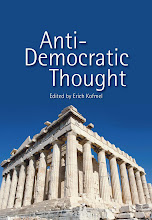Elliot Hen-Tov, "Understanding Iran's New Authoritarianism" ("The Washington Quarterly", 30 [1], January 2007: pp. 163-79):
www.informaworld.com/smpp/content~db=all~content=a918257573
Excerpts: "Iran is in fact undergoing a gradual process of regime change, not moving toward democratization but rather modifying Iran's brand of authoritarianism. It constitutes the beginning of a marked shift from the existing clerical theocracy toward a more conventional authoritarian regime. [...] This transition will therefore see remnant democratic features erode as the evolving regime concentrates power among a small number of key decisionmaking centers. Similar to other authoritarian regimes, the role of the military-security apparatus will be enhanced, as will the regime's dependence on tools of patronage or repression to assert full control. [...] Profound structural problems in Iran's economy will prevent the leadership from implementing the China model – authoritarianism with high economic growth – but Iran's oil-based economy nevertheless provides the regime with sufficient resources to satisfy its supporter base and discourage opposition. [...]
"After years of reformist meddling, [...] the conservatives used antidemocratic measures to recapture municipalities in 2003, the Majlis [parliament] in 2004, and the presidency in 2005. [...] The June 2005 presidential elections bore more resemblance to elections in other semicompetitive authoritarian regimes. Although antidemocratic in nature, the elections did offer an array of choices. [...] The prominent elevation of intelligence and security figures under Ahmadinejad is a product of their increased role during the Khatami years of silencing and intimidating reformist sympathizers. [...] The successful acquisition of nuclear weapons would accelerate a militarization of Iran's regime. [...]
"Even if the regime has recently had to subdue disgruntled youth, demographic trends indicate that the regime might soon not even be required to call on its coercive apparatus. As birth rates began to drop toward the end of the Iran-Iraq War in 1988, demographic pressure has been easing, with the last of the baby boomers due to enter the labor market by the end of this decade. Subsequently, the labor force growth rate will shrink to 1.7 percent, about half of the rate in 2000 and easily supported by current [economic] growth. Recent evidence of Iran's economic and social order suggests that the regime does not face an imminent popular challenge and certainly has the means to confront any domestic opponents until this demographic reversal is completed."
Elliot Hen-Tov, a doctoral candidate in the Department of Near Eastern Studies at Princeton, has been advising senior officials at the United Nations on Middle Eastern and European issues since 2006.
23 March 2010
Subscribe to:
Post Comments (Atom)





No comments:
Post a Comment